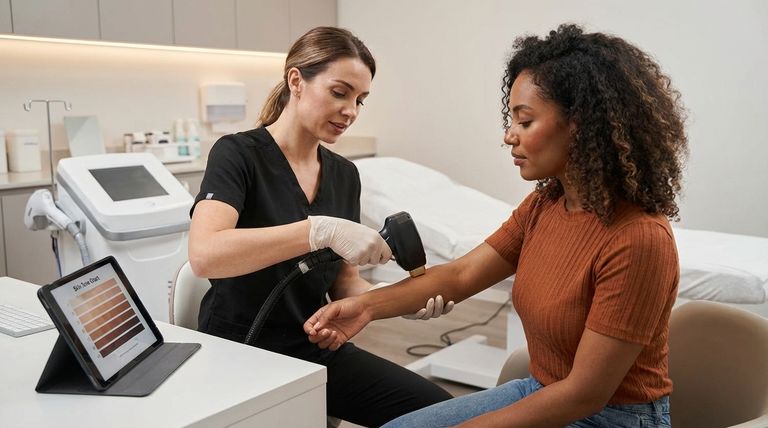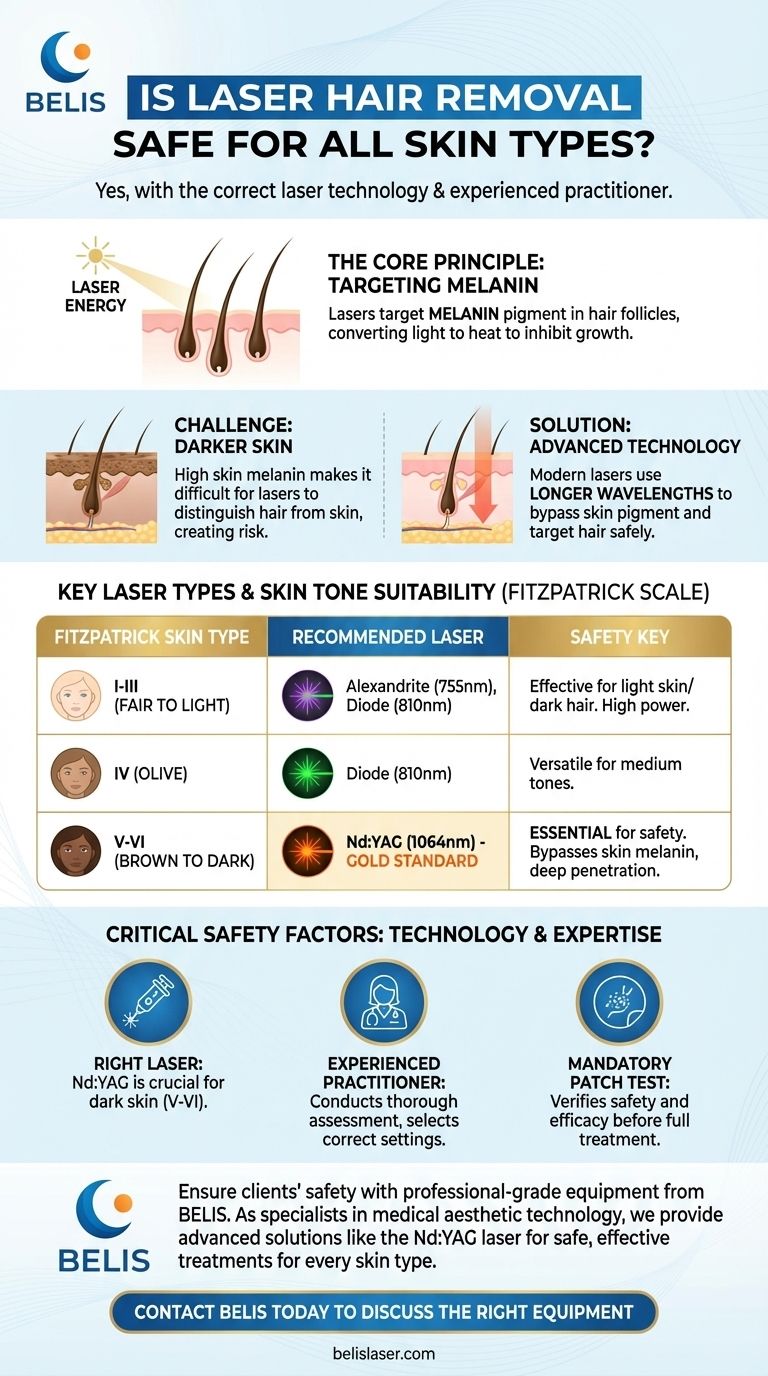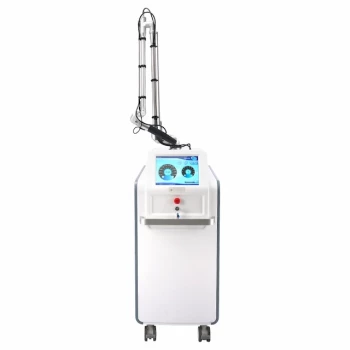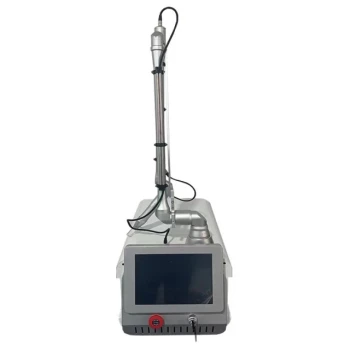The short answer is yes, with a critical qualification. Modern laser hair removal technology has advanced to a point where it can be safely administered on nearly all skin types, from the very fairest to the very darkest. However, its safety is not universal or automatic; it is entirely dependent on using the correct type of laser for your specific skin tone, wielded by a highly experienced practitioner.
While the technology exists to treat a wide range of skin tones, safety is not inherent in the procedure itself. It is a direct result of matching the right laser wavelength to your skin's melanin content—a task that demands expert knowledge and the correct equipment.

The Core Principle: How Lasers Target Hair
To understand the safety implications, you must first understand the mechanism. Laser hair removal is a process of selective photothermolysis, a precise way of using light to create heat in a specific target.
Understanding Melanin
The target for the laser's energy is melanin, the pigment that gives both your skin and your hair its color. Dark hair is rich in melanin, making it an ideal target.
The Laser's Goal
The laser emits a concentrated beam of light at a specific wavelength. This light is absorbed by the dark melanin in the hair follicle, instantly converting to heat. This heat damages the follicle, significantly inhibiting its ability to grow new hair.
The Challenge with Darker Skin
The central challenge arises when the surrounding skin also has a high concentration of melanin. An unsophisticated laser cannot easily distinguish between the melanin in your hair and the melanin in your skin. This creates a risk of the laser energy being absorbed by the skin itself, not just the hair follicle.
The Evolution of Laser Technology for Skin Safety
Early laser systems were limited precisely because of this challenge, making them safe only for a narrow range of candidates.
The Old Way: High Risk for Dark Skin
First-generation lasers, and even some contemporary but less advanced systems, use shorter wavelengths of light. These wavelengths are very aggressively absorbed by melanin, making them highly effective for light skin with dark hair but extremely risky for darker skin tones. Using these on darker skin can lead to burns and pigmentation issues.
The Modern Solution: Longer Wavelengths
The breakthrough for treating darker skin came with the development of lasers that use longer wavelengths, specifically the Nd:YAG laser.
This laser's 1064nm wavelength is key. It is less readily absorbed by the melanin in the top layer of skin (the epidermis) and can penetrate deeper to reach the hair follicle. It effectively bypasses the pigment in your skin and selectively targets the pigment in your hair, dramatically increasing the safety profile for skin rich in melanin.
Key Laser Types by Skin Tone
- Alexandrite (755nm): Excellent for lighter skin types (Fitzpatrick I-III). It is very powerful and fast but carries a higher risk for tanned or darker skin.
- Diode (810nm): A versatile laser that is effective for a slightly broader range of light to olive skin tones (Fitzpatrick I-IV).
- Nd:YAG (1064nm): This is the gold standard for safely and effectively treating darker skin tones (Fitzpatrick IV-VI). Its long wavelength is the single most important safety feature for this group.
Understanding the Trade-offs and Risks
Choosing the right laser is only half the battle. True safety comes from combining the right technology with the right professional.
The Risk of Incorrect Technology
Using the wrong laser on dark skin is the most significant risk in this field. It can cause serious and sometimes permanent damage, including:
- Burns and Blisters: From excessive heat absorption by the skin.
- Hyperpigmentation: Dark spots caused by an inflammatory response in the skin.
- Hypopigmentation: Light spots caused by the destruction of melanin-producing cells in the skin.
- Scarring: In the most severe cases of burns.
The Critical Role of the Practitioner
The technology is only a tool; its safety depends on the operator. An experienced technician will conduct a thorough assessment of your skin using a system like the Fitzpatrick scale, which classifies skin tone based on its reaction to UV light. They will select the correct laser and, just as importantly, fine-tune the settings (like energy level and pulse duration) to match your specific skin and hair characteristics.
Insist on a Patch Test
A reputable provider will never treat a new client without first performing a patch test. By treating a small, discreet area and waiting to observe the reaction, the practitioner can verify that the chosen settings are both safe and effective for your skin before you commit to a full session.
Making the Right Choice for Your Treatment
Your active participation is crucial for ensuring a safe outcome. Focus your evaluation on the provider's technology and expertise, not just the price.
- If you have fair to olive skin (Fitzpatrick I-IV): You have more flexibility with laser types, but you must still prioritize a provider who performs a thorough consultation and explains their technology.
- If you have brown or dark skin (Fitzpatrick V-VI): You must verify the clinic uses a long-pulse Nd:YAG laser. Ask the technician directly about their experience and success in treating your specific skin type.
- For all skin types: Never proceed without a patch test. It is the ultimate confirmation that the treatment is tailored correctly and safely for you.
Ultimately, the safety of laser hair removal rests on the crucial partnership between advanced technology and expert human judgment.
Summary Table:
| Fitzpatrick Skin Type | Recommended Laser Type | Key Safety Consideration |
|---|---|---|
| I-III (Fair to Light) | Alexandrite, Diode | Effective for light skin with dark hair. |
| IV (Olive) | Diode | Versatile option for medium skin tones. |
| V-VI (Brown to Dark) | Nd:YAG | Essential for safety; bypasses skin melanin. |
Ensure your clients' safety and satisfaction with professional-grade equipment from BELIS.
As a specialist in medical aesthetic equipment for clinics and premium salons, we provide the advanced technology—like the crucial Nd:YAG laser—that enables safe, effective treatments for every skin type. Partner with us to elevate your service offerings and build unwavering client trust.
Contact BELIS today to discuss the right equipment for your practice.
Visual Guide

Related Products
- Diode Laser SHR Trilaser Hair Removal Machine for Clinic Use
- Clinic Use IPL and SHR Hair Removal Machine with Nd Yag Laser Tattoo Removal
- Diode Tri Laser Hair Removal Machine for Clinic Use
- Clinic Diode Laser Hair Removal Machine with SHR and Trilaser Technology
- Trilaser Diode Hair Removal Machine for Beauty Clinic Use
People Also Ask
- Does diode laser remove hair permanently? Understanding Permanent Hair Reduction
- How does diode laser hair removal work? The Science of Targeting Hair Follicles
- What skin type is diode laser for? Safe Hair Removal for Light to Dark Skin
- What are the disadvantages of diode laser hair removal? Key Limitations & Safety Risks Explained
- Which is better, an IPL or a diode laser? Unlock Precision for Permanent Hair Reduction



















